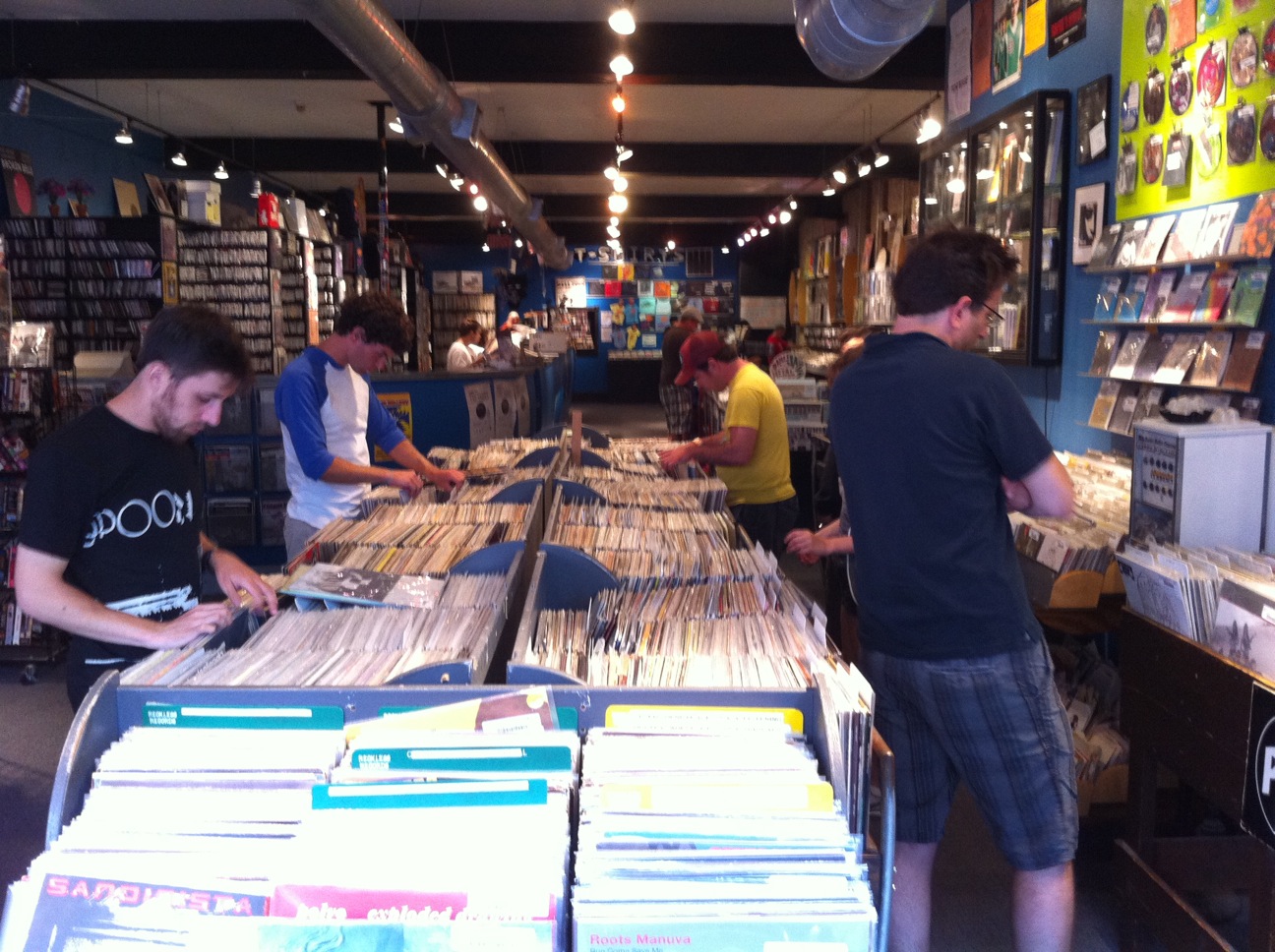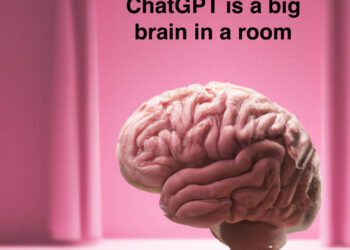
Over the last few years, I’ve been buying more music on vinyl than I have since, well, ever. I realize this is a bit anachronistic. I’m not one of those audiophile types who go on and on about how much better music sounds on vinyl. I do think it sounds a bit warmer but really to my ears it is not that big a difference. Mainly I buy vinyl because I enjoy the whole experience of the record.
It starts at the local record store, where I seem to always to find really knowledgeable people who turn me on to great music. In Chicago, I lived a few blocks down from the legendary Reckless Records on Milwaukee Avenue, the model for the record store in the movie High Fidelity. Here in Charlottesville, I am right around the corner from the fabulous Melody Supreme, whose proprietor always has a great recommendation. I realize there are services like Pandora, Spotify, iTunes Genius, and Soudhound, and I use all of these. But I continue to value the non-algorithmic connections of the human mind when it comes to music association and discovery.
I also buy records at concerts. I tend to go to a lot of indie rock shows, and indie bands are selling a lot vinyl these days. Most bands have a table at the back of the concert venue with t-shirts and posters and records. A lot of bands I see are not huge acts, and so often the table is staffed by a spouse or relative of one of the band members. This often leads to interesting conversations that lend a whole other dimension to the experience.
Beyond the act of discovering and buying records, I like the records themselves. Album artwork is much more integral to the record than with digital music and there is so much more of it. In addition to the front cover of the record sleeve, there is the back cover, which you never see when you purchase music online. Some albums come with two records, which necessitates one of these record jackets that opens like a book — with additional artwork. Then there is the artwork on the interior dust jacket and often artwork on the record itself (the most iconic example being the various apples that appeared on Beatles albums published by Apple Records).
And then there is the playing of records. There is a ritual to it that adds to the experience. I delight in taking the record off the shelf, taking it out of its sleeve, placing it on the turntable, lifting the needle arm, powering the turntable up, and gently dropping the needle on to the spinning record. Then, of course, there is the crackle of sound that lets you know you are listening to a spinning disc of vinyl. You won’t convince me the sound of the needle dropping on to the first track of Side A of the Black Key’s El Camino doesn’t lend an indelible quality missing from digital editions. A world without that crackle would be a poorer place to live.
But here is the catch: I am not that big a vinyl aficionado to the point where I would ever chose vinyl over digital music. As much as I love the experience of buying and listening to records, digital music is just so much more convenient. You can listen to it on your phone, in your car, on your computer, through your stereo, while you exercise, on the plane, and so on. Digital files don’t get scratched, and they are backed up to various hard drives and clouds. Also, you can buy just one song as opposed on a whole album. And as much as I like going to the record store or to the table at a concert, there is no beating the “download” button on iTunes (or Amazon or Google Play or eMusic or whathaveyou) in terms of convenience. On the whole, digital music is just vastly more convenient than analog formats. So as much as I appreciate the experience of buying records, I’m highly unlikely to buy a record and then go and buy the music again via an online store. That would get really expensive. If the choice is between vinyl and online digital download, digital wins every time. Fortunately, that is a choice that increasingly I don’t have to make.
What indie rock bands have figured out is that the purchase of music does not have to be an either/or proposition. They don’t make their customers choose between analog or digital. Whenever you buy a record from just about any indie band, it comes with either a CD or with a card that contains a URL and a download code so you can get a digital copy at no additional cost.
The indie bands and their record labels realize that they are not going to sell both vinyl and digital to the vast majority of their customers. That is just too expensive a proposition for any but the most devoted and dedicated fans who also happen to be audiophiles (granted this is a larger segment among indie rock fans than other musical genres but still, I wouldn’t want to build a business plan around it). But they also know that they make more money on vinyl (mainly because they are more assured of selling the whole album as opposed to a few hit songs) and so would prefer to sell you vinyl. By including a digital download with the vinyl, they are gaining a more valuable customer. They are making more money and are simultaneously giving their customers what they want. They realize that they are not cannibalizing their revenue by “giving away” the digital edition because they were never going to make both sales.
And guess what? This strategy works: vinyl is in resurgence. According to Nielsen Soundscan stats, vinyl sales in 2012 are up 16.3% over 2011, which was itself a banner year. More vinyl will be sold in 2012 than in any year since 1991. Eight of the best selling vinyl records in 2012 are indie bands (the other two are by Adele and the Beatles, because really, how can anyone pass up a copy of Abbey Road on vinyl?). Granted, vinyl is never going to sell beyond a niche audience, and it will never approach digital sales absent a zombie apocalypse. But it does prove the viability of a business strategy that has an analog in the publishing trade: hardcover books.
Hardcovers books have similar characteristics to vinyl records. They can be bought in independent book stores that often have knowledgeable staff. The physical artifact is a pleasure to hold and to read. It has a fidelity that is not yet matched via the digital medium. There is a ritual to taking a book off the shelf, settling into a favorite chair, and losing oneself in the text. And like the vinyl record before it, the hardcover book is losing ground to digital formats. According the Association of American Publishers, as reported in GalleyCat, 2012 is the first year that revenues from e-book sales will eclipse that of hardcovers. E-books are gaining traction in the market for the same reasons that digital music has become the dominant format: convenience. It is more convenient to simply press a “Download to Kindle” button than to trudge out to the bookstore (as pleasant as it might be once you are there) or even to order a physical book online. It is also far more convenient to pack a single Kindle with multiple books on it as opposed to packing numerous physical books when traveling.
Hardcover readers are a publisher’s best customer. They are willing to pay more for a higher quality (as compared to paperback) product. I would be interested to hear from readers of the Scholarly Kitchen as to what percentage of e-book titles command the same margins as hardcover sales. Given that many publishers continue to delay release of e-books until some weeks after the hardcover appears in an attempt to maximize hardcover sales, I suspect that hardcover sales remain the preferred format from a revenue perspective.
Beyond today’s revenue figures, however, a vibrant trade in print books serves as a bulwark against the concentration of e-book stores. Compared to the thousands of booksellers remaining in the world, there are but a handful of e-booksellers — and Amazon outsells all the others combined. As publishers become more and more dependent on revenue from e-book sales, they will become increasingly beholden to a small number of distributors. At present, sales of print books provide enough revenue from other sources for publishers to have some room to maneuver. As I discussed in a recent post, there is still time for publishers to make decisions that will lead to a more competitive e-book ecosystem. Extending the life of hardcover sales as long as possible will buy publishers more time to do just that. The mistake the music industry made was waiting until they had no other options before dealing with Steve Jobs and Apple, who bargained accordingly.
So how might publishers extend the life of lucrative hardcover sales and at the same time buy themselves time to foster a more competitive e-book marketplace? By taking a cue from indie record labels (I know, you didn’t see this one coming) and including a digital download with every hardcover purchase.
There are likely many people like myself who prefer a solid hardcover. I like the feel of it, am more comfortable reading on paper as opposed to a screen, and I sleep better knowing that it will probably not mysteriously vanish from my bookshelf if the computer system at the bookstore I purchased it from doesn’t like my travel patterns. However, given that I do travel a lot, carrying a heavy hardcover (or three) around is just not practical. Just as with music, I like the analog edition and am willing to pay more for it, but I am not going to choose it over the vastly more convenient digital edition – and I am most certainly not going to buy both. So why are publishers making their best customers choose and watching idly as they do in fact choose, in increasing numbers, a format that is not as lucrative for publishers and that is rapidly leading to an over-reliance on a small number of distributors?
If implemented in the right way, publishers could kill two birds with one stone: they could support a mechanism for downloading e-books purchased in conjunction with hardcovers that not only makes their best customers happy and extends the life of hardcover sales, but that actually fosters competition in the ebook marketplace. If publishers were to decide to partner with organizations other than (or in addition to) the incumbent tech and retail giants to support e-book downloads, it will introduce more competition into the marketplace.
Moreover, publishers can use such a distribution mechanism to encourage the use of non-proprietary formats and DRM-free files, thus removing two critical hurdles to a more competitively e-book marketplace. Publishers could choose to only partner with organizations that offer e-books in DRM-free open formats (just as with the indie music digital music files that accompany record purchases). In fact, this could be a powerful sales incentive. There are a large number of readers, myself included, who are uncomfortable with the proprietary lock-in of the e-book marketplace today. I don’t want to make a substantive investment in a library that might suddenly be revoked if I move to Norway (which is especially disconcerting as I imagine a cabin next to a fjord would be as especially pleasant place to get some reading done). If publishers offered readers a hardcover along with a non-proprietary DRM-free e-book at no additional cost, many customers will opt for that combination as it assures the stability of one’s e-book library and provides a hardcover “backup” for the non-virtual bookshelf.
Over time, there will be a number of well-heeled book readers (e.g. hardcover purchasers) that have amassed sizable libraries of e-books in open, DRM-free formats. These customers will grow accustomed to such formats and will begin expecting them when they make e-book-only purchases. Moreover, if publishers use this as an opportunity to inject new competition into the marketplace by working with organizations beyond the giant tech and retail incumbents (or at least beyond the giant tech/retail incumbent), these same customers will grow familiar with other platforms and modes of distribution. They will develop purchasing habits around them. And they will also demand software to integrate libraries of ebooks purchased from disparate distributors, further catalyzing competition among distributors by encouraging format standardization (document management applications such as Papers and Mendeley, for example, work within the context of the scholarly publishing ecosystem due to the near ubiquity of the PDF format).
With the lifespan of the market for hardcover books extended and the market for e-books more competitive, publishers can then learn other things from indie rockers – like how to wear skinny jeans with cowboy boots and how to grow a mustache this side of the 1970s.
Discussion
34 Thoughts on "What Can Publishers Learn from Indie Rock?"
Wow! I really liked your article, found very interesting insights, specially the one where you state that readers won’t buy a Hardcover and an e-book, specially when the prices are really similar.
Great post! The book business is looking a lot like the record industry and you spelled it out brilliantly. Anyone that is looking to self-publish, should be reading your posts.
Good article, Michael. Coach House Books in Toronto announced last February – http://www.chbooks.com/news/coach-house-offers-free-digital-downloads-print-purchase – that they were offering free digital downloads with the purchase of any print book. I don’t know if they’re still doing so, or how it’s going for them, but I’ve always thought this was a bright idea for publishers. Like vinyl records, books will continue to exist in the digital era, but primarily for connoisseurs and collectors, who will pay a premium price for print books, as opposed to the bulk of consumers, who will opt for cheap, disposable e-books. I also think the “backup” angle you mention is an important selling feature, especially for libraries, which may be reluctant to acquire e-books because of their ephemeral nature.
Michael, good stuff. A couple thoughts, which might be obvious, pop into my mind as it relates to journal publishing: Couldn’t (or aren’t they already) the “really knowledgeable people who turn me on to great music” at the record store = “really knowledgeable people who turn me on to great research” be publishers and editors? Also, many Societies (such as the one I work for) have been using the “print bundled with digital” model you suggest for some time. Membership includes print copies of journals as well as online access (and now access via a mobile app). This is viewed by some as an “old fashioned” model, but maybe it’s just ahead of its time? 🙂
Editors and publishers are clearly going to have to get some hipper t-shirts if they want to play that role. I agree – publisher and editors provide the same time non-algorithmic connections I was referring to.
With regard to journals, as I wrote about in a post earlier this year (http://scholarlykitchen.sspnet.org/2011/12/07/the-costs-of-print/) the key is to bundle in the right direction. If one wants to pay more for the print book/journal/record, then by all means let the customer do so and throw in (a.k.a. “price in”) the electronic edition (though price it in with the understanding that you are not going to make both sales). However, I think many publishers are still bundling in the other direction by not offering online-only subscriptions/memberships. By bundling in this direction, many publishers are actually loosing money. This is because 99% of journals don’t make enough money on print advertising to cover the cost of printing and shipping. And most journals that bundle (especially with membership) could do away with print without changing pricing and thereby save the (often considerable) cost of printing and shipping.
So I am all for bundling digital with a print purchase but I’m not sure the reverse makes sense in the context of journals.
I agree that the digital copy should come free with the physical copy, especially when the purchase of a digital copy really amounts to more of a revokable rental (by the bookstore, as you mention).
In addition to the benefits you list, publishers can use the free digital copy to connect directly with readers. By selling only the hard copy in stores and through online retailers, and including a code for downloading the digital copy, they can request (and probably get) basic customer information in exchange for the digital copy (the usual “Give us your email address so we can send you a link to the download, and would you like us to let you know about other great offers, or subscribe to our newsletter–we never spam!”). From a marketing perspective, that’s a huge potential win for the publisher at no real cost.
Thanks for your comment Dave. I can’t believe I forgot to mention this critical point! You are absolutely correct, that an enormous benefit (to the publisher) of offering a “free” digital download is that the publisher can then identify their real customer: the reader. Most publishers have no idea who is buying the vast majority of their print books. By offering a digital download, publishers can do precisely as you suggest, and ask readers to create an account (thereafter they can have one-click download). In creating an account, publishers can ask for a name, email address, and other basic information. At that point, they have a direct relationship with their end user. And the cost of establishing this direct relationship is essentially nothing (at least on a per-transaction basis – there would presumably be set-up costs associated with a digital distribution platform of some sort) as they were never going to make both the print and the digital sale. Good catch.
This is so self-evidently a good idea, it is almost certainly never going to happen. I would definitely be in the market for this kind of experience: I now never buy hardbacks over a digital copy, but I do miss the experience of cracking open a new book in front of the fire – I just don’t ant to lug it on the tube with me.
Reblogged this on thirtyroses and commented:
Add your thoughts here… (optional)
One difference is that generally I listen to a specific bit of music many times but read a book only the once. I also don’t care where I start, stop and pick up an album or playlist. I do with a book.
So once I’ve committed to a book then it’s either paper only or digital only as I can’t flip between the two media (though I can between two digital devices). And once read I then don’t need the other version (except for particular favourites: Graham Greene’s Power and the Glory comes to mind).
So I’m not sure the consumer really gains value for most book purchases whereas they definitely would with music.
If I really love a book, or even just experience it in an important way, I almost always read it more than once. I’ve read Finnegans Wake and Ulysees thrice each, Gravity’s Rainbow, Against The Day, Vineland and COL49 all twice, Our Mutual Friend twice, and The Place Of Dead Roads more times than I can count. If a book enters my life I want it in my house.
Interesting. Nick Carr also made this suggestion a while back: http://www.roughtype.com/?p=1573
Excellent article! As a book collector who loves the tangible product on my shelves but would love to have my collection on an easily transportable digital format/device for sheer reading convenience, I’ve resisted e-reader devices (in fact, three years ago I had to return a Kindle my mother gave me as an Xmas present) simply because I’m just way too used to having something tangible for the amount of money I’m spending. Never mind that it would cost me thousands of dollars just to restock my digital bookshelf with books I already have purchased.
I’ve always said that if publishers began including a digital copy with purchase of the physical copy, even if it’s only the HC edition as you suggest, I would definitely be more open to purchasing a device. I would likely be willing to pay a slight charge for that option. That is, if I spend $25 on a HC, the normally-priced ebook would be available to me at purchase for $1.
Ouch. “The hardcover book is *losing* ground to digital formats,” not “loosing.”
“So why are publishers making their best customers choose and watching idly as they do in fact choose, in increasing numbers, a format that is not as lucrative for publishers and that is rapidly leading to an over-reliance on a small number of distributors?”
Really well put. I agree.
Great post! You and I have similar media-buying preferences, and I’ve been saying to friends and family for some time now that hardcovers should come with free e-books. Thanks for stating this argument so persuasively.
The analogy with music breaks down in one respect: there is no real threat from buyers of books compared with buyers of music comparable to the preference music buyers may have for wanting only a track or two and not a whole album; chapters are not like songs in this way.
Publishers who are providing free online access to full text of books while selling POD editions (like the National Academies Press) are already satisfying customers in this way. The difference is that the customers don’t have to buy the print edition in order to have access to the e-book.
Reblogged this on Self-Publishing Advocate.


